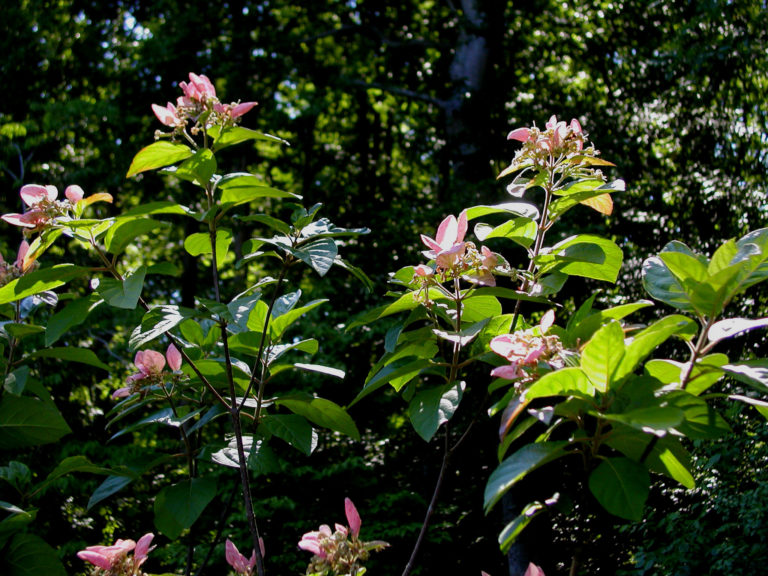Fevertree is a large, graceful, deciduous shrub or small tree valued in the landscape for its rich green foliage and a long lasting display of beautiful pink in midseason. While the actual flowers of the Fevertree are greenish yellow and inconspicuous, these are surrounded by large, showy, whitish to deep rose sepals (usually pink), which provide a splash of welcome cool pink in the heat of high summer. Fevertree is endemic to Southern Georgia and Northern Florida, and to the southern tip of South Carolina (it grows nowhere else), and is considered threatened. Its habitat is on the margins of swamps, bays and streams. It can develop root rot in sustained wet conditions but grows well and suckers less in rich, moist, well drained upland soil. This is one of the great gifts from our Deep South (along with Magnolia virginiana var. ‘australis’ and Magnolia ashei) — a beautiful if short-lived plant. (We have had several in the ground for at least 10 years and they are thriving.) It can sometimes grow to thirty feet but its mature height is usually on the order of about fifteen feet. The inner bark of the Fevertree is extremely bitter but is proven to treat fevers, the source of several of its common names. The fruit is a dry capsule.
NURSERY HOURS
Wednesday: 10-4 Thursday: 10-6 Friday-Saturday: 10-4 Sunday: 12-4
Pinckneya bracteata (formerly Pinckneya pubens)

Key Info
Scientific Name: Pinckneya bracteata (W. Bartram) Raf.
Common Names: Fevertree, Poinsettia tree, Georgia bark, Pinckneya, Feverbark
Family Names: Rubiaceae (Madder Family)
Plant Type: Tree / Shrub
Leaf Retention: Deciduous
Flower Color: Inconspicuous yellowish green flowers with showy, large, rose pink bracts.
Special Characteristics: Tolerates some flooding, Long blooming period, Rhizomatous especially in wet, Attracts butterflies
Additional Info
Habit: Large, open shrub or small tree woody stems w/ white lenticels and conical buds
Height: 10'-30'
Spread: 5-15'
Soil Conditions: Quite acidic but can survive on alkaline; cool, damp but well-drained soil; muck, sand, sandy loam, sandy peat.
Leaves: Large, coarse, waxy, rich green, elliptical to ovate leaves are concentrated at branch ends.They are opposite, simple, 3 to 7 inches long , entire, shiny dark green above, fuzzy below.
Flowers (or reproductive structures: The yellowish-green, pinkish or reddish brown streaked, fleshy, tubular flowers with five reflexed linear lobes and exserted stamens, are inconspicuous relative to the very showy sepals, in shades of pink, 3-4 inches long which appear in late spring in loose clusters (cymes) at branch ends.(VaTechDendrology)
Fruit: Dark brown, 2-valved seed capsule, 1/2 to 2/3 inch in diameter, ripen in late summer and fall and persist into winter. (VaTechDendrology) Seeds 2 mm or 1/3 inch), thin, round wing.
Natural Distribution: Low woods; margins of sloughs, swamps & streamsbay margins, stream banks, swamps
USDA Hardiness Zone: 7 to 9
USDA Wetland Indicator Status in NC: OBL
Pollination: Principle pollinators are Cloudless Sulfur Butterflies as they feed on the nectar. Ruby-throated Hummingbirds and bumblebees (Bombus spp) are also cited.
Wildlife Connections: Is a host plant for several Lepidoptera, the silver spotted skipper and the variable Oakleaf Caterpillar.
Propagation: Propagate by fall-sown seeds or cuttings from young plants. Seeds require no pretreatment.
